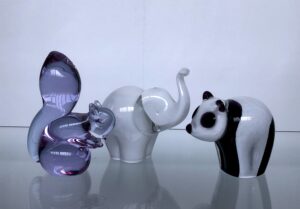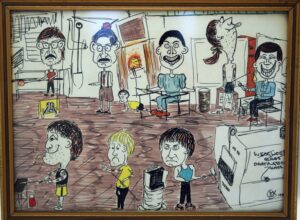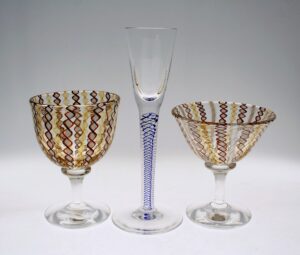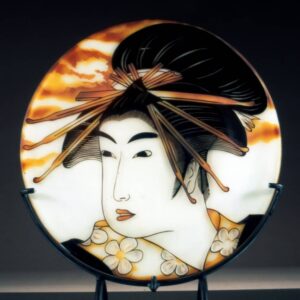How does anyone cram 25 years let alone 50 years of glassmaking into a few paragraphs? I’ll give it a go!
So I started work at the Wedgwood Glass factory in June 1974. I knew nothing about glassmaking, and in reality, I hadn’t given it much of a thought as to how glasses were made, so this was a real eye-opener. I remember it being hot, really hot, and noisy too with all those furnace fans blowing. The factory had 10 large 500lb pot furnaces although one was used to arch the pots and another was off for a good number of years, both were at the back end of the hot shop. Opposite, the 2 lehrs also had multiple fans blowing hot air inside the different temperature zones to give a uniform temperature during the annealing process.
My first “gaffer” was Italian, my second was Austrian, my third was from Stourbridge and my next was from Whitefriars Glass, so there was a mixture of different talents. Also, there were gaffers from Strathearn Glass in Scotland, one from Germany, and the rest were local lads who had worked their way up the ranks.
I watched Enzo, the Italian master make small animal “friggers” during dinner breaks, he annealed them in the vents at the side of the furnaces. That’s where I cooked my baked potato or frozen curry, piping hot in 20 minutes.
Wedgwood Glass mainly made tableware, candlesticks, paperweights and animal paperweights. I was put into stem teams to train. I read about where the colleges “formally train” students. I really don’t see that the students get the time to be formally trained. My training was extensive, initially, I was shown by Jim, the gaffer from Stourbridge. It was a case of showing me to look for the shadow of the iron on the surface in the pot, lower it until it touched, another inch and turn pushing forward until the “metal” builds up then over to the left breaking the glass to surface contact then out. I did this until I was competent at gathering the same sized “bit” while keeping it round and off the end of the iron. It’s called repetitive training. From there I went into a training team where I spent the last hour of every day gathering stems and feet for candlesticks. I remember the blue and green glass being quite stiff while the purple and topaz soft to gather.
After training, I was put in a stem team gathering for lead crystal wine glasses, from there I progressed into another stem team that was more versatile, wines, candlesticks, and paperweights. 11/1’s to be exact, the domed weights with the bubbles and rings. Then the animal paperweights took off, at the beginning of my employment there was only one team making them, then shortly after two teams, the orders for the animals took off. Virtually all the teams were making them, but we had to be trained, so it was apples and pears first, followed by elephants and polar bears then squirrels, dolphins, and seals. We were formally trained to make everything, and as we all worked piece-work we had to make each piece to a quality control standard, which was pretty high. It was a great place to learn this trade, our repetitive formal training proved to be invaluable. I was making strong foundations for the future, although I didn’t know it at the time.
Sometime around 1984-5 Wedgwood merged with Dartington Glass, we were called English County Crystal. I was formally trained every Saturday to blow wine glasses. Initially, it was a case of learning to mold blow and look for mistakes, like blowing too hard and producing rings in the bowl, to burning in molds and checking for raised marks that produce rings. The piecework numbers were for “Theo” sherry about 160 per hour, for goblets about 110 per hour, all had to have a wall thickness of 1mm to 1.5mm. You don’t achieve that sort of quality in the making processes without being “formally trained”.
It was towards the end of 85 beginning of 86, I don’t remember exactly, that I was moved to the centrifuge team…a job I definitely didn’t want to do…even my blisters had blisters! I would empty a 500lb pot in the morning and be moved to another half-full and empty that as well…My body wasn’t built for this type of work! I started to look for other glassmaking jobs elsewhere.
When Wedgwood owned the factory I had plenty of time to practice making “friggers” or learning how to make cane techniques. My fascination with cane techniques stemmed from a book called “The Golden Age of Venetian Glass” by Huge Tait, and a filigree marble I’d won at school aged about 9-10. I showed all the gaffers the marble asking if they knew how it was made, the only person who knew was Andy, who worked at Strathearn Glass in Scotland, he simply said you need to make canes. So, through “trial and error” scenarios, over hundreds of dinner breaks, I eventually managed to make filigree and murrine canes. When Wedgwood and Dartington merged I was too exhausted to play “studio” during breaks, I had to save my strength for the afternoon session!
We move to Wales.
A few of us were headhunted, to work at a new cut crystal factory that was opening in Powys, Mid-Wales. I was promised to be trained to “chair” a team, it was a great opportunity for me, and within a short time, I was “chairing ” a team, well Ted! I continued to make friggers, learning as I went along. I made my first twisted stemmed glass and two cane-worked glasses, I even designed some ranges for the company. Unfortunately due to the saturated cut crystal market, it was inevitable that it failed. It was sad that we had to move, as we both loved it there, Powys is a beautiful part of the world, and geographically totally different to Norfolk.
I looked elsewhere for work and spent the next 4 years commuting from Scotland to Wales working for a studio in the Borders. The work was easy, too easy at times. The owner thought that making 36 glasses in a day was fantastic…I had blown that amount in minutes. I guess the more you’ve experienced the more you know…or in some cases, didn’t want to know. I was allowed to make my work during breaks, perfecting filigree cane work, making two nice candelabras, plus 3 “Geisha” cameo plates. All of this to keep my sanity, and skills alive. I eventually got so bored making their production work that I believed I was losing skills.
I knew there had to be more to glassmaking than this…!
The dream of setting up my own ‘Studio” would soon be a reality!



